Foxconn Blood Rage - If Looks Could Kill (UPDATE)
by Rajinder Gill on January 2, 2009 6:00 AM EST- Posted in
- Motherboards
It's All About Brawn... Well, Maybe
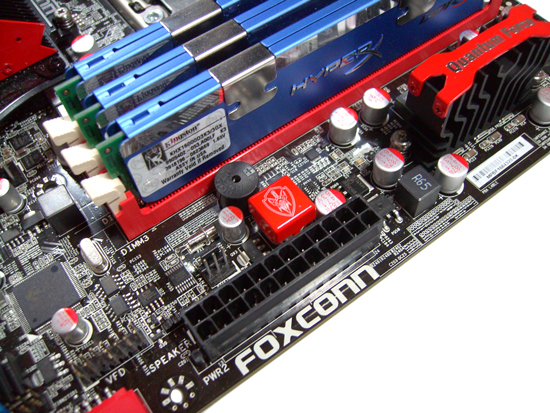 If your CPU and parts are anything like ours, you'll soon find that this "Force Reset" button is your new best friend. |
We're not sure if our situation is unique, but that statement above relates to the fact that all three of our boards refuse to cold or stop-cycle-boot without pressing the "Force Reset" button. Once the board is running, we can apply changes to BCLK reference clocks as long as we don't change major parameters such as clock multipliers. Foxconn's manual states that use of this button resets the system and tunes the board to perform optimally with your components. We think it's primary use is related to boot up memory module read/write leveling performed by the IMC to sense module density/capacitive loads and apply clock/data skew table algorithms and/or a simple reset of all IRQ assignments. This is something that usually happens during the black screen period of the boot cycle on other boards.
As an override, the idea is sound as those of us who push components find ourselves frequently going through complete power cycles to bring boards back to boot. For us though, our boards refuse to function properly without it. Regardless of stock speeds, moderate overclocks, or the more out-on-a-limb stuff, we need to press this button every time to get the board to fire up from a change to a related BIOS function. In order to overcome this we tried PSU swaps and five brands of memory using various ICs and attendant SPDs. A BIOS update should easily fix this problem if the boot cycle configuration is moved back into automated hands. We've alerted Foxconn to this and hope to hear back from them soon. If you happen to stumble across a combination of parts that results in this scenario, you'll need to keep the side panel off your PC case. However, if you run your motherboards out of a case -- as most benchmarking fanatics do -- this probably won't bother you.
Let's press on and get down to the maximum stable speeds we achieved. First up, we have a PCMark Vantage full suite pass at 4.1GHz.
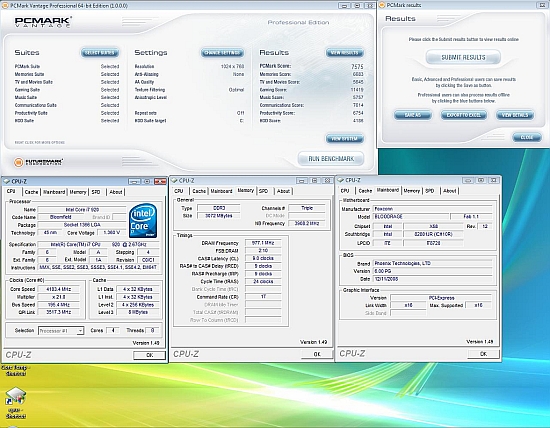 |
This overclock is right on the limits of our water-cooled setup for 24/7 use. 100% processor load temps are in the region of 75C, about as far as we'd expect the processor to remain stable and over the sensible mark for many. VTT/Uncore voltage is critical and needs a sizable boost over stock to around 1.52V for Vantage to pass a full test suite loop on our retail i920 processor.
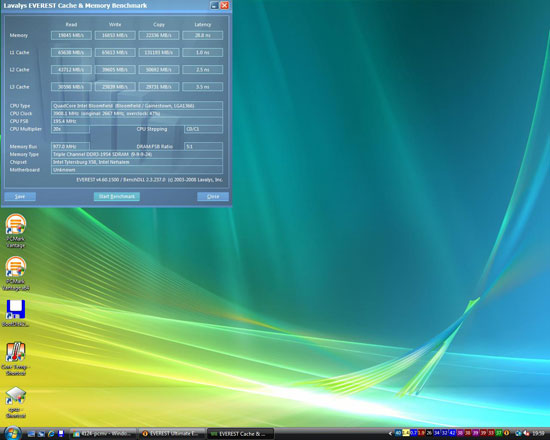 |
Everest Bandwidth on the Nehalem platform is beyond reproach using triple channel memory. In truth, there's little benefit running past 1600MHz, but we thought we'd try it as the Blood Rage virtually demands it. (This and the fact that the Kingston kit is specified to run 2000MHz at 1.65V). On a side note, longer eight thread enabled Prime95 runs were destined to fail unless we increased the Uncore voltage to around 1.54-1.56V. Using a lower memory divider ratio decreases the level of Uncore Voltage required; using the 2:8 divider resulted in a fully stable pass at 1.47V. The required level of Uncore voltage is largely processor dependant, though board design does come into play as we have noticed on the DFI and ASUS boards. With a good CPU, you may get away with less voltage.
Dropping the BCLK reference to 190MHz brings the required level of Uncore voltage down to 1.45V while running the 2:10 memory ratio at 1915MHz 1T in triple channel configuration. This passes a 1 hour OCCT run, multiple loops of PCMark Vantage, and several games with ease.
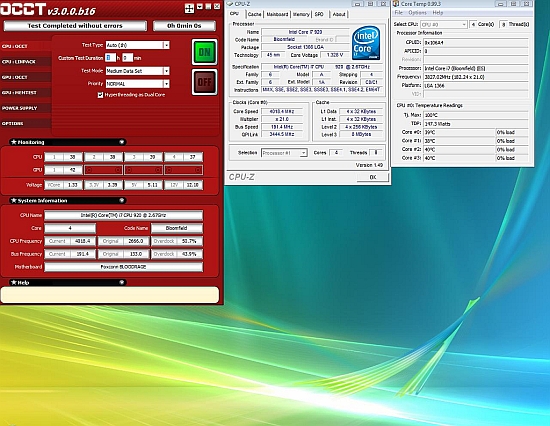 |
We included our test BIOS settings below for those that want to set up the board quickly before tuning it. However, there's not really much to it on this platform, other than the golden rule of keeping VTT/Uncore voltage within ~0.5V of VDDQ (VDIMM). Until we discuss additional secrets of Nehalem overclocking in the coming i7 Guide, it's a game of setting four or five key voltages and letting the BIOS do the rest. One other note to remember is to set the Uncore frequency to a minimum of 2X the memory multiplier. Failure to do so will result in a non-boot in all manual setting situations.
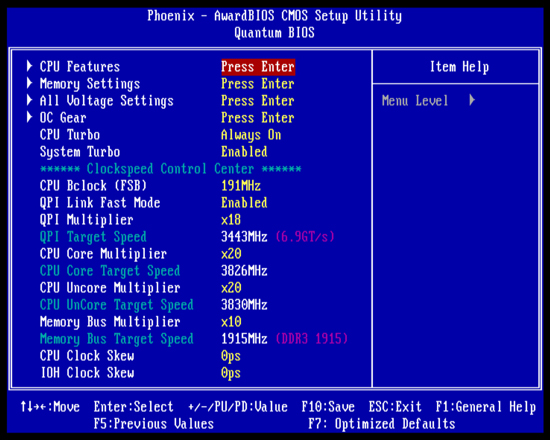 |
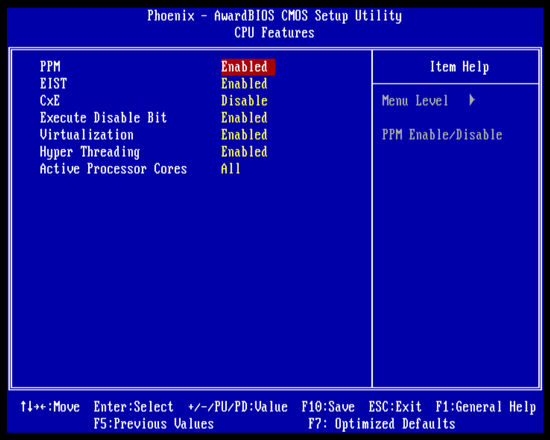 |
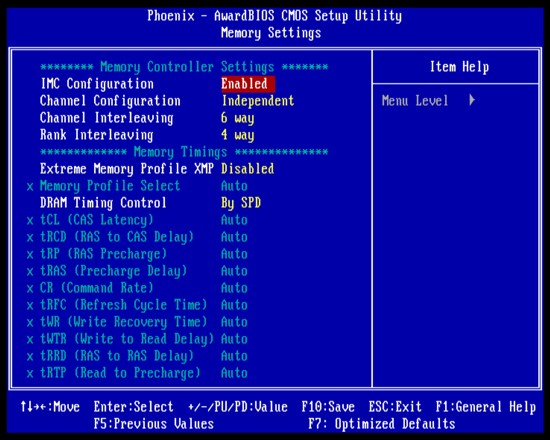 |
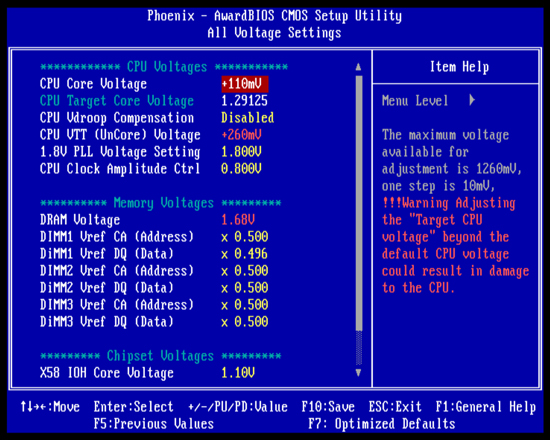 |
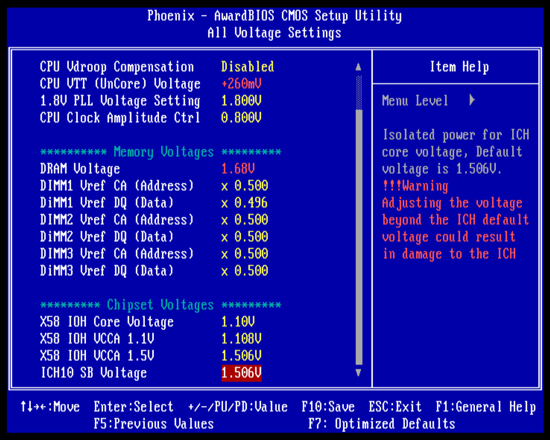 |
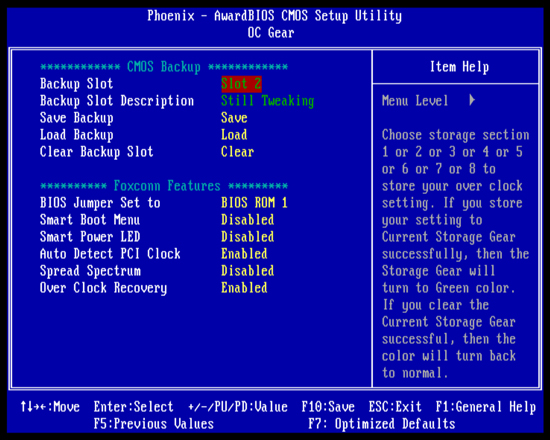 |
On the voltages screenshot you will notice that DIMM1 DQ Ref voltage is set to 0.496X. We found this situation manifests itself whenever we ran our Kingston or G.Skill DDR3-2000 memory in a triple channel configuration. All things being ideal, these values should retain as close to 50% of VDDQ (VDIMM) as possible, unless overshoot and ringback signal effects are affecting the DATA DQ sampling window excessively (which can and does happen at higher bus frequencies).
There is a massive 62 step scale available for each of the ref voltage levels; however DIMM1 remains locked to 0.496V regardless of what you select in BIOS. We tried multiple times to reset this value to 0.50X but found the board would reset to 0.496X after boot every time. We're not sure if this is a "red-button artifact" or if this is a BIOS bug at this point. We are leaning towards a BIOS bug, as a manual user setting should work properly. If it is a bug, then a change as small as this is in the wrong direction is enough to result in an incorrect logic interpretation at very high memory speeds. We have alerted Foxconn to this and await a response.










66 Comments
View All Comments
davekozy - Saturday, January 3, 2009 - link
Asus is already releasing version 2 of the P6T Deluxe less than 2 months after the first was released. From what I've read the main difference is the loss of the SAS connectors. Companies with good product support release bios fixes as often as needed. There are 4 bios updates for the first P6T Deluxe or about one every two weeks since release. There have been 8 so far for my 6+ month old Asus P5Q. Evga has 7 bios updates already for their X58 board. That's almost one a week! There are a lot of issues the beta-testers aka early adopters (including AT) have helped resolve.gemsurf - Saturday, January 3, 2009 - link
Sorry if I let the dogs out Rajinder and I hope it is all taken in context. We don't have the voice that this site does and thru you maybe some of this can improve? We have all trusted Anands for a very long time and I certainly hope he is reading these comments as well. Thank You all for what you do!Rajinder Gill - Saturday, January 3, 2009 - link
Not at all. The reason I did not sensationalize the issue is becasue many others are not experiencing the problems. It's still random. I plugged in an OCZ Pro Xstream today and the board works fine. The variables involved in parts mismatches, batch changes, underhood revisions are so numerous. In the end I felt it better to highlight the possibility. Might not have been what you wanted to see, but the point was there regardless, and from my perspective understood too.later
Raja
Scott66 - Sunday, January 4, 2009 - link
Another website had to switch to a different power supply as their usual benchmarking one did not cold boot the system.kilkennycat - Friday, January 2, 2009 - link
Have you noted that there is a recession? Core i7 is nowhere near mainstream, the current version of Core i7 is not optimised for desktop, being too power-hungry, and the motherboards and memory are ridiculously-priced. Maybe I am "all wet", but it might be very revealing to generate a survey of Anandtech readers with regard to their computer-system purchase intentions within the next 3-6 months.Why 3-6 months? The current bunch of Core i7 motherboards are very obviously first-generation beta-phase efforts. It takes somebody with a whole bunch of money and an "early-adopter" mentality to have the fortitude to buy any of them. It is going to take 3-6 months for Core i7 to be considered mainstream and by that time Anandtech is going to have to update a whole bunch of these X58 motherboard reviews. Meanwhile, there is a huge price/performance sweet-spot in the Penryn and Phenom domains with some incredibly comprehensive offerings out there. For just one little example, it is disappointing that the full Anandtech review of the MCP7A/9300/9400 motherboards has continued to be delayed, presumably by the pressure of completing these "bleeding-edge" X58 reviews.
ssj4Gogeta - Saturday, January 3, 2009 - link
I'm probably going to wait until Westmere.LoneWolf15 - Friday, January 2, 2009 - link
Yep.After having to purchase a board unexpectedly this week, and some thought, I've decided on Gigabyte's GA-EP45-UD3P.
Current reviews almost seem to make it look dated, despite it being a relatively recent board. But considering I'm going from an Intel BadAxe2 (when I buy a board, I want a good board that will last a few years), a P45 chipset is quite new. System also supports DDR2; quality DDR2 is still half the price of DDR3, and it supports faster processors than I need (including my existing Q6600). Add that it also has ICH10R for RAID, firewire, and a ton of ports, and I can save a lot of money over getting an i7 that is certainly cool, but beyond what I need. All for under $150 shipped.
Paulywogstew - Friday, January 2, 2009 - link
In the Board & Features overview you state its a socket T 775 interface???Kroneborge - Friday, January 2, 2009 - link
IMO, bios revisions for better performance etc are ok, and to be exptected. Bios revisions to get basic functionality working are not.When you make a purchase you expect it to work as advertised or it's going back. If you can't get a bios ready by then, then delay release. Develop a repuataion for rock steady performance, and people will beat a path to your door to develop your product, EVEN if they have to wait a extra month or two too purchase.
JonnyDough - Friday, January 2, 2009 - link
Agreed. Every time I took that brief AMD survey upon a visit to their site I always put that I looked for STABILITY in drivers. Why would I want to get 300fps in a game if it's going to crash on the last level and not let me win?